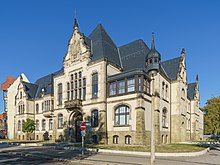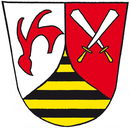Quedlinburg district
| coat of arms | Germany map |
|---|---|

|

|
| Basic data (as of 2007) | |
| Existing period: | 1994-2007 |
| State : | Saxony-Anhalt |
| Administrative headquarters : | Quedlinburg |
| Area : | 540.38 km 2 |
| Residents: | 71,429 (Jun 30, 2007) |
| Population density : | 132 inhabitants per km 2 |
| License plate : | QLB |
| Circle key : | 15 3 64 |
| Circle structure: | 25 municipalities |
| Address of the district administration: |
Heiligegeiststrasse 7 06484 Quedlinburg |
| District Administrator : | Wolfram Kullik ( SPD ) |
| Location of the district of Quedlinburg in Saxony-Anhalt | |
The district of Quedlinburg was a district in the west of the state of Saxony-Anhalt , which was opened up on July 1, 2007 in the newly created district of Harz .

geography
The district of Quedlinburg had a share of the Harz in the southern district area . In the northwest the Bode flows through the former district area. The district recently bordered seven other districts with the following district towns (clockwise, starting in the northeast):
- District of Halberstadt : Halberstadt ( Saxony-Anhalt )
- Bördekreis : Oschersleben ( Saxony-Anhalt )
- Aschersleben-Staßfurt district : Aschersleben ( Saxony-Anhalt )
- Mansfelder Land district : Eisleben ( Saxony-Anhalt )
- District Sangerhausen : Sangerhausen ( Saxony-Anhalt )
- Nordhausen district : Nordhausen ( Thuringia )
- District of Wernigerode : Wernigerode ( Saxony-Anhalt )
Administrative history
German Empire
The forerunner of the district of Quedlinburg was the district of Aschersleben , which was established in 1816 in the Prussian province of Saxony . When the city of Aschersleben left the district in 1901 , the remaining district became the district of Quedlinburg . In 1911 Quedlinburg also became an independent city ; the district has since been called the district of Quedlinburg . On September 30, 1929, a territorial reform took place in the Quedlinburg district in line with developments in the rest of Prussia, in which all independent manor districts were dissolved and assigned to neighboring rural communities. After the dissolution of the province of Saxony on July 1, 1944, the district belonged to the new province of Magdeburg . In the spring of 1945 the district was occupied by the American forces.
GDR
On July 1, 1950, the boundaries of the district of Quedlinburg, which was now part of the newly founded state of Saxony-Anhalt , were changed by an initial administrative reform in the GDR:
- The city of Quedlinburg, which has been a district since 1911, was incorporated into the district of Quedlinburg.
- All municipalities of the dissolved district of Ballenstedt were incorporated into the district of Quedlinburg.
- The towns of Blankenburg and Hasselfelde and the communities of Allrode , Altenbrak , Börnecke , Cattenstedt , Stiege , Timmenrode , Treseburg and Wienrode moved from the dissolved district of Blankenburg to the district of Quedlinburg.
- The city of Ermsleben and the communities of Dankerode , Königerode and Meisdorf moved from the disbanded Mansfeld mountain district to the district of Quedlinburg.
- The municipality of Heteborn moved from the district of Oschersleben to the district of Quedlinburg.
- The community of Straßberg moved from the district of Sangerhausen to the district of Quedlinburg.
- The district of Quedlinburg gave the communities Groß Schierstedt and Westdorf to the district of Bernburg .
In the course of the major administrative reform of 1952 , the area of the district was changed again on July 25, 1952:
- The cities of Cochstedt , Ermsleben and Hoym as well as the communities Friedrichsaue , Frose , Gatersleben , Hausneindorf , Hedersleben , Heteborn , Königsaue , Meisdorf , Nachterstedt , Radisleben , Reinstedt , Schadeleben , Wedderstedt , Wilsleben and Winningen came to the new district of Aschersleben .
- The communities Groß Börnecke and Schneidlingen became part of the new Staßfurt district .
- The cities of Blankenburg and Hasselfelde as well as the communities Altenbrak , Börnecke , Cattenstedt , Stiege , Timmenrode , Treseburg and Wienrode came to the district of Wernigerode .
- The other cities and communities formed the district of Quedlinburg .
- The districts of Quedlinburg and Aschersleben were assigned to the new district of Halle ; the districts of Staßfurt and Wernigerode to the new district of Magdeburg .
Federal Republic of Germany
In 1990 the district of Quedlinburg was part of the new federal state of Saxony-Anhalt and renamed the district of Quedlinburg again. During the first district reform in Saxony-Anhalt in 1994 , it was enlarged by municipalities from the Aschersleben district (Hausneindorf, Hedersleben, Heteborn, Wedderstedt and Radisleben) and reduced by its communities Allrode and Timmenrode (to the Wernigerode district).
With the second district reform on July 1, 2007, the district of Quedlinburg became part of the new district of Harz .
The district maintained the remaining cultural institutions:
- Nordharzer Städtebundtheater (together with the cities of Quedlinburg and Halberstadt and the district of Halberstadt)
- Lyonel Feininger Gallery in Quedlinburg
- District library in Quedlinburg
Population development
The scope of the county changed in 1911, 1950, 1952 and 1994.
| year | Residents | source |
|---|---|---|
| 1910 | 72,966 | |
| 1925 | 47,844 | |
| 1933 | 46,540 | |
| 1939 | 46,578 | |
| 1946 | 63,886 | |
| 1955 | 105,800 | |
| 1960 | 99,326 | |
| 1971 | 96.148 | |
| 1981 | 89,724 | |
| 1990 | 86,400 | |
| 2000 | 78,800 | |
| 2007 | 71,429 |
politics
District administrators
- 1816–1823 Gotthelf Schmaling
- 1823–1864 Carl Weyhe
- 1864–1903 Otto Stielow († 1908)
- 1903–1917 Georg von Jacobi
- 1917–1919 Karl Vollrad from Doetinchem de Rande
- 1919–1926 Hermann Müller
- 1926–1932 Paul Runge (SPD) (1877–1948)
- 1932-1933 Claus
- 1933–1934 Philipp Harte
- 1934–1939 Horst Naudé (1895–1983)
- 1939– Franke
- 1942–1945 Albert Rudolph
The district administrators after the political change in 1989 were:
- 1990 Wolfgang Hoßbach (SPD), resigned after 16 days in office
- 1990–1994 Detlef Mahlo (CDU)
- 1994–2000 Dieter Zehnpfund (SPD), until reaching retirement age
- 2000–2007 Wolfram Kullik (SPD), until the end of his electoral term
- 2007 Martin Skiebe (independent), acting deputy until the district is dissolved
coat of arms
The approval from the Ministry of the Interior of Saxony-Anhalt took place on September 24, 1990.
Blazon : "Divided by silver and red by a curved tip divided nine times black over gold, in front a four-ended red antler rod bent to the left, behind two obliquely crossed silver sideboard knives with gold handles."
The coat of arms reminds with the coat of arms images of the historical territories over which the district stretched. The antlers can be traced back to the coat of arms of the County of Regenstein , the sideboard knives to that of the Imperial Monastery of Quedlinburg , while the multiple black and gold division symbolizes the County of Ballenstedt .
The coat of arms was designed by Udo Glathe from Quedlinburg (Heraldic Society "Black Lion" Leipzig). Since the black-gold division at Glathe erroneously began with gold, the municipal heraldist Jörg Mantzsch subsequently redesigned the coat of arms on behalf of the district council.
Cities and municipalities before 1950
In 1945 the district of Quedlinburg comprised two cities and 22 other municipalities:
Cities and municipalities 1990–2007
Administrative structure 2007
(Resident on December 31, 2006)
- Quedlinburg , City (22,185)
Administrative communities with their member communities
Headquarters of the administrative association *
|
|
Territory changes since 1995
Since 1995 there have been many changes to the area in the district of Quedlinburg.
Of the original 6 administrative communities, there were still 4 administrative communities when the district was dissolved. At the same time, the number of parishes decreased from 27 to 25.
Changes in administrative communities
- Dissolution of the Quedlinburg administrative community - incorporation of the Westerhausen community into the Thale administrative community ; Quedlinburg becomes a unified municipality (January 1, 2004)
- Formation of the administrative community Ballenstedt / Bode-Selke-Aue from the administrative communities Ballenstedt and Bode-Selke-Aue (January 1, 2005)
Changes at the community level
- Dissolution of the Badeborn community - incorporation into Ballenstedt (August 4, 2002)
- Dissolution of the Warnstedt community - incorporation into Thale (December 21, 2003)
economy
Together with the districts of Halberstadt and Wernigerode, the district founded the North Harz Waste Association. In this, the problem of waste disposal at low fees was solved.
The economy in the district of Quedlinburg had been determined by a few but large industrial companies - hut in Thale, die-casting and piston works Harzgerode, Mertik Quedlinburg, Philopharm Quedlinburg, rubber works Ballenstedt. These could not assert themselves in the market economy and were processed except for rudiments. That meant unemployment well above the average in Saxony-Anhalt.
License Plate
At the beginning of 1991 the district received the QLB distinguishing mark . It was issued through June 30, 2007. It has been available in the Harz district since November 27, 2012.
Web links
- District of Quedlinburg Administrative history and district list on the website territorial.de (Rolf Jehke), as of May 31, 2015.
- Internet portal for the former district of Quedlinburg
- Legends and stories from the district of Quedlinburg
Individual evidence
- ↑ a b genealogy.net: Quedlinburg district
- ↑ a b c d e f g Michael Rademacher: German administrative history from the unification of the empire in 1871 to the reunification in 1990. Quedlinburg district. (Online material for the dissertation, Osnabrück 2006).
- ↑ 1946 census
- ↑ a b Statistical Yearbooks of the German Democratic Republic. In: DigiZeitschriften. Retrieved October 6, 2009 .
- ↑ a b Statistical Yearbooks of the Federal Republic of Germany. In: DigiZeitschriften. Retrieved July 6, 2016 .
- ↑ State Statistical Office Saxony-Anhalt, monthly issue 11/2007



